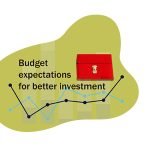
A range of factors held back the segment.
- The start of 2021 saw excessive positioning in passive exchange-traded funds (ETFs).
- A marked rise in interest rate and inflation expectations penalised long-duration growth assets such as environmental stocks.
- Inflation caused by supply bottlenecks and a significant rise in freight rates led to market concerns over margin and profit compression.
- Investors struggled to value the type of innovative companies generally associated with thematic growth. [1]
Attractive valuations
In late 2021, positioning in the environmental thematic universe had fallen to at its lowest in three years. Meanwhile, companies in the segment generally had one of the best earnings seasons in 20 years in the context of demand vastly outstripping supply.
Valuations for our energy transition innovation universe fell to less than half those of equities in the US Nasdaq index [2] despite having more than 1.7x the earnings growth (3-year compound annual growth).
It should come as no surprise that for 2022, we are upbeat on the environmental theme relative to broader equity markets that are likely see volatility amid the push and pull of monetary policy action, the pace of interest rate moves and earnings growth developments.
We believe this dynamic should benefit our long/short absolute return strategy that typically thrives in uncertain and volatile markets.
Stock selection is crucial in 2022
2021 saw a historically wide dispersion of performance between growth and value sectors, with the MSCI World Integrated Oil & Gas and MSCI World Financials indices up by 41% and 31%, respectively, while the MSCI Global Alternative Energy index fell by 7%.
We believe that 2022 could see a substantial reversal: While we have subscribed to peak oil and prices overshooting, we believe that oil market rebalancing in combination with demand destruction is likely to see oil prices retrace over the medium to longer term.
In view of the volatility in gas and power prices, the world has woken up to the need to accelerate the build-out of renewable energy infrastructure, including wind, solar, energy storage and hydrogen. This is needed to both decarbonise economies and achieve energy and geopolitical security.
With population growth still accelerating and, along with climate volatility, increasing the pressure on global food systems, food price inflation is rising. This in part is why investing in the restoration of the world’s lands and oceans has become a top priority for policymakers. It is also a core theme within our ecosystem restoration strategy.
Thematically, we see the most attractive investment opportunities in companies that operate with significant competitive advantages, particularly in segments that have high barriers to entry.
- We also prefer platform businesses that can gain a meaningful operating advantage from upselling and service revenues compared to manufacturing and intermediary goods companies in more commoditised parts of the supply chain, where competition and margins are tighter.
Thematic investing can help deliver on the COP26 priorities
The latest UN Climate Change Conference took encouraging steps towards additional major climate pledges and policy agreements to further develop and deploy technologies that can reduce CO2 and methane emissions significantly, as well as restore and protect the world’s natural capital.
The principal areas of focus at COP26 included:
- Green hydrogen
- Residential solar energy
- Offshore wind energy development
- Energy storage to reduce carbon emissions
- Practical packaging solutions to reduce plastic pollution
- Land-based fish farming to address fish depletion
- Sustainable farming methods to protect the world’s soils.
All these areas are investable themes covered by the Environmental Strategies Group at BNP Paribas Asset Management.
[1] The Environmental Strategies Group applies top-down total addressable market models, technology life cycle theory and long-term discounted cash flow modelling to assess the value of innovative companies in this space.
[“source=investors”]




